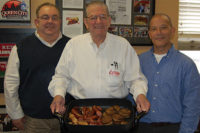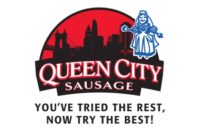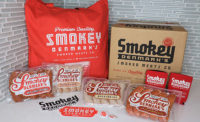Anyone who makes jokes about sausages being of questionable origin hasn’t looked at a grocery store or restaurant lately. There’s no mystery meat to be found in the current generation of sausages. Instead, there is top-quality meat, occasionally combined with fruits, vegetables, cheeses and more, and spiced to reflect tastes and recipes from around the world. Old World sausages are still, and will always remain, popular, but given the creativity of today’s sausagemakers, exotic flavors abound.
According to a 2010 study from Information Resources Inc., sausages are enjoying remarkable sales, and those sales figures are still on the rise. Figures for 2010 show that dinner sausage retail sales increased 3.4 percent, with more than 1.85 billion in sales. Breakfast sausage sales increased as well, at more than 9 million in sales. The National Hot Dog & Sausage Council found in a survey that the residents of the Deep South consume the most dinner sausage, followed by the Northeast.
Located in Union City, Tenn., and with a distribution that covers 10 states in the Southeast, Williams Sausage is located in the right place. The company produces whole-hog country sausage in chubs, links, patties and in breakfast sandwiches. Pre-rigor sausage, like the kind the company produces, is especially popular in the Southeast.
“The time from when we kill the hog to when it’s packaged is usually less than an hour. You get a better texture,” says Roger Williams, president. “Of course, by being whole hog, we’re using all the choice cuts - the hams, loins, tenderloins - in the product, rather than just the trimmings. It makes for a much leaner product.”
Williams Sausage has seen tremendous growth in its fully cooked and breakfast sandwich products, which Williams points out follows the trend toward convenience food items. The company is in the process of adding on an additional 35,000 square feet to its facility in a $10 million expansion project. Williams says that the project, expected to be completed by September, will add on another cooking line and make more room for breakfast sandwich production.
Further north, in Claremont, N.H., North Country Smokehouse has also seen an increased interest in the breakfast daypart. Michael Satzow, president, says that breakfast sausage sales have increased for the last four or five years. The company’s fresh maple sausage and its smoky maple sausage link are doing particularly well.
“We’re seeing our fresh sausage sales are skyrocketing, and we’re one of the largest users of maple syrup in Vermont and New Hampshire because we make so much of the maple sausage,” he says. Satzow says that the company’s high-end foodservice accounts, caterers and other customers have done very well with the company’s applewood bacon, which led them to look at other ways to further enhance breakfast.
North Country’s maple fresh and smoked pork sausages are strong sellers, but the company’s most popular sausages also include a chicken apple sausage and an Andouille sausage.
“We’ve been making that for probably 15 years, and it amazes me that a New Hampshire producer could make so much of a Cajun sausage,” Satzow says with a laugh. He says that a number of foodservice customers have begun utilizing the sausage.
As proof that sausage is an upscale, gourmet item, Satzow says he has seen an increase in the use of sausages used on flatbreads, including the Andouille and chicken apple sausage, as well as tomato basil or jalapeno chicken sausage.
“I think the modern foodie is concerned about ordering a pizza with a lot of sauce and cheese on it, and they’re looking for a much more upscale presentation,” he says. “The flatbread provides that.”
Gourmet sausages are also en vogue at Chico Locker & Sausage Inc., located in Chico, Calif. Owner David Dewey says that the company makes traditional sausages, but two of his top-sellers are a jalapeno cheddarwurst and Linguica.
“Linguica is a coarse-ground Portuguese sausage that’s spiced with paprika, garlic, wine and vinegar,” Dewey says. He says that he’s introduced several other sausages, such as a Mediterranean sausage and a chicken cordon bleu sausage, which have also done well.
“It fits the California cuisine pretty well,” he says. “It’s usually low-fat, low-salt and a little different. They key on a lot of light foods [that] tend to be chicken-oriented. You have to adjust to that, and we do.”
Dewey, who has won many awards at the American Cured Meat Championships, says that when he enters products, he sometimes has to increase the salt content, because the taste his customers expect may not match what the judges expect.
Top ingredients
Dewey notes that Californians may tend to spend time reading food labels, but they still love a grilled steak as much as anyone else. Chico Locker’s big summer product is a tri-tip, and he tries to incorporate sausages into his customer summer cook-out plans as well.
“We marinate probably 10 different varieties of tri-tips, and I try to market the sausages as an appetizer,” he explains. “We still sell them with the sauerkraut and peppers and onions, and try to make it a center-of-the-plate item too.”
Dewey says that he doesn’t consider himself to be a European sausagemaker, though he makes many Old World favorites, such as Polish and German sausages. Many of his other popular offerings feature cheeses, such as a cheesy garlic, a chicken jalapeno cheddarwurst and a ham and Swiss sausage.
High-quality ingredients are a key element in making a tasty sausage. North Country Smokehouse was one of the first companies in its area to make a maple sausage, but the company’s innovation goes well beyond syrup.
“We have people who are buying more of our sausages where we’ve added wine to them,” notes Satzow. “We make an apple summer sausage with Vermont wine, we make a chorizo sausage with brandy, and we make a whiskey fennel sausage.
“[I’ve seen] vintners that have really come into their own with high-quality wines,” he adds. “You have hundreds of people up here making cheeses, where 10 or 15 years ago there was no one.”
Satzow says that he is constantly challenged by his chef customers who are looking for different variations, and the company will work with the chefs to develop the desired product.
“We feel that if one chef wants it, then a number of chefs would like it,” he reasons. He also gets inspiration from the salad dressing aisle at supermarkets. Salad dressing manufacturers are constantly developing new and unique products to try and stay ahead of the competition, and some of those concepts can be translated over to sausages as well.
“There’s so much high-quality food in supermarkets, that inspiration is the least of my problems,” Satzow notes. The cost of making many small-run sausages can become a problem, but he says that can be alleviated by making a large enough mother batch with the basic seasonings and then dividing it into smaller batches. From there, he can add apples, mangoes or any other desired inclusions.
Naturally, all the ingredients in the world can’t disguise a sausage made with cheap meat. Chicken sausage, which has become a cheaper and healthier alternative to pork sausage, has to be done correctly to achieve the proper texture. Chicken, because of its lean nature, has a tendency to be dry as well.
“I think the problem a lot of people have is that they’re so tempted to use mechanically deboned meat, and we won’t use that in our facility,” Satzow says. “We only use 100-percent chicken thighs, and we use a seasoning matrix to make sure it retains the moisture.”
Satzow says he would rather take a sausage and look for a way to enhance the value of the meat instead of looking for a way to make it cheaper.
“Fortunately, I’ve always been able to find someone who’s willing to pay for the quality, rather than the value,” he says.
Williams Sausage has maintained similar standards for its sausage products. Along with making sausage from the whole hog instead of trimmings, the company does not use a former to make its sausage patties. Rather, the meat is stuffed into plastic casings and frozen, prior to it being sliced.
“A sliced patty versus a formed patty goes back to the texture of the meat, but we just think it tastes better to do it that way,” Williams explains.
High-tech help
The sausage has a long history, and an expert sausagemaker is as much a craftsman as a businessman. That does not mean that technology can’t be utilized to make a good thing even better.
Williams notes that almost all of Williams Sausage’s meat goes through a chub process, whether it’s sold in 1- or 2-pound chubs or put into longer chubs for patty slicing. The technology on the chub-makers has improved and provides a higher output than ever before. The company is bringing in another high-speed chub maker to keep up with the demand.
The chiller is another important aspect of the whole-hog sausage production, as the meat is still about 80 degrees when it is packaged.
“You’ve got to go through the quick-chill process, and the propylene glycol chiller really speeds up the process,” Williams says, “and because you get it frozen so quickly, your shelf life is so much better.”
Satzow says that consistency in the finished product is important, which is why he values North Country’s linker and its ability to produce sausages in equal weight and length.
“It’s worth the investment if you get the return,” he says.
Not that it always costs tens of thousands of dollars to improve a sausage, of course. A good casing can make all the difference as well.
“We use a collagen casing for our breakfast sausages, because we find that with our equipment, we get a really good product with a good bite,” Satzow says. For other sausages, he uses a pork casing, though lamb casings are becoming more popular among people who don’t eat any pork products. “We had a large hotel chain that feeds its help lunch every day,” he says. “They employ a large number of Muslims, and they wanted to feed them sausage, but they couldn’t find a sausage that wasn’t made with a pork casing. So we developed a product for them using lamb casings.”
Smaller companies are able to take advantage of technology, too. Chico Locker has a vacuum stuffer with a linker attachment and a grinder and mixer. As a result, Dewey says, he can make a sausage in two hours that used to take eight or more hours.
In the end, though, an eye to detail is still needed. Dewey points out that the top positions at the American Cured Meat Championships are often decided by just a handful of points. Many of the entries taste good, so oftentimes the outward appearance is the deciding factor.
“Pay attention to detail. Make sure your color is uniform, and [avoid] smoke stick marks and water marks,” he says. “All those points for appearance are easy to come by, and they’re usually workmanship related.”




Report Abusive Comment